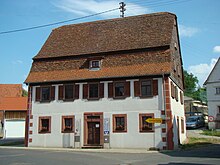Oberwittstadt
Oberwittstadt is a district of Ravenstein in the Neckar-Odenwald district in Baden-Württemberg . At the end of 2011 the population was 615.
Geographical location
The densely built-up village of Oberwittstadt is located in the far east of the Neckar-Odenwald district, bordering the Main-Tauber district and the Hohenlohe district , in a valley widening of the Hasselbach, which flows into the Erlenbach . On this, near the southern boundary of the district , lies the Heckmühle residential area , east of the village in the valley of another indirect and higher Erlenbach tributary, the also associated hamlet of Schollhof .
history
The first traces of settlement date from the Neolithic Age and are covered with a stone tool made of chert. After the Franks settled the area in the 6th century, Oberwittstadt was almost completely destroyed in the Thirty Years' War . The first written mention of the place took place in 774 in the Lorsch Codex as a Witegen act on the occasion of a donation by an Isenhart . After frequent changes of ownership, it was assigned to the Grand Duchy of Baden in 1806. During the Second World War, Oberwittstadt lost over a fifth of its current population. On December 1, 1971, Oberwittstadt and its five neighboring communities Merchingen, Hüngheim, Erlenbach, Ballenberg and Unterwittstadt merged to form the community of Ravenstein, which received town charter in 1974. Thus, the former own municipalities now bear the title "District" and Ravenstein the title "City".
Attractions
- The Catholic Church of St. Peter and Paul in the center of the village dates from the 18th century.
- The Bonifatius Nothelfer Chapel outside of the village dates from the 12th century. Its altar with a representation of the 14 emergency helpers was created in 1456. Peter Valentin Feuerstein designed the windows of the chapel .
- The so-called Heilighaus in the center of the village was built in 1787. The reasons why the house was designed so extraordinarily lordly by the client, Joseph Kilian, are no longer known today. It got its name from the long-time owners in the 19th and 20th centuries, the Heilig family.
- The Aloysenhäusel , a day laborer's house from 1536/64, was moved to the Odenwald Open Air Museum .
Web links
- Oberwittstadt on the Ravenstein website
- LEO-BW, discover regional studies online , Oberwittstadt
Individual evidence
- ↑ Minst, Karl Josef [trans.]: Lorscher Codex (Volume 4), Certificate 2892, November 2, 774, Reg. 1118. In: Heidelberger historical stocks - digital. Heidelberg University Library, p. 258 , accessed on April 5, 2015 .
- ^ Federal Statistical Office (ed.): Historical municipality directory for the Federal Republic of Germany. Name, border and key number changes in municipalities, counties and administrative districts from May 27, 1970 to December 31, 1982 . W. Kohlhammer, Stuttgart / Mainz 1983, ISBN 3-17-003263-1 , p. 474 .
- ↑ The Oberwittstätter day laborer's house from 1536/64 ("Aloysenhäusel") in the Odenwälder Freilandmuseum (museum sheets of the Odenwälder Freilandmuseum 1) , Walldürn 1999
Coordinates: 49 ° 26 ' N , 9 ° 34' E



